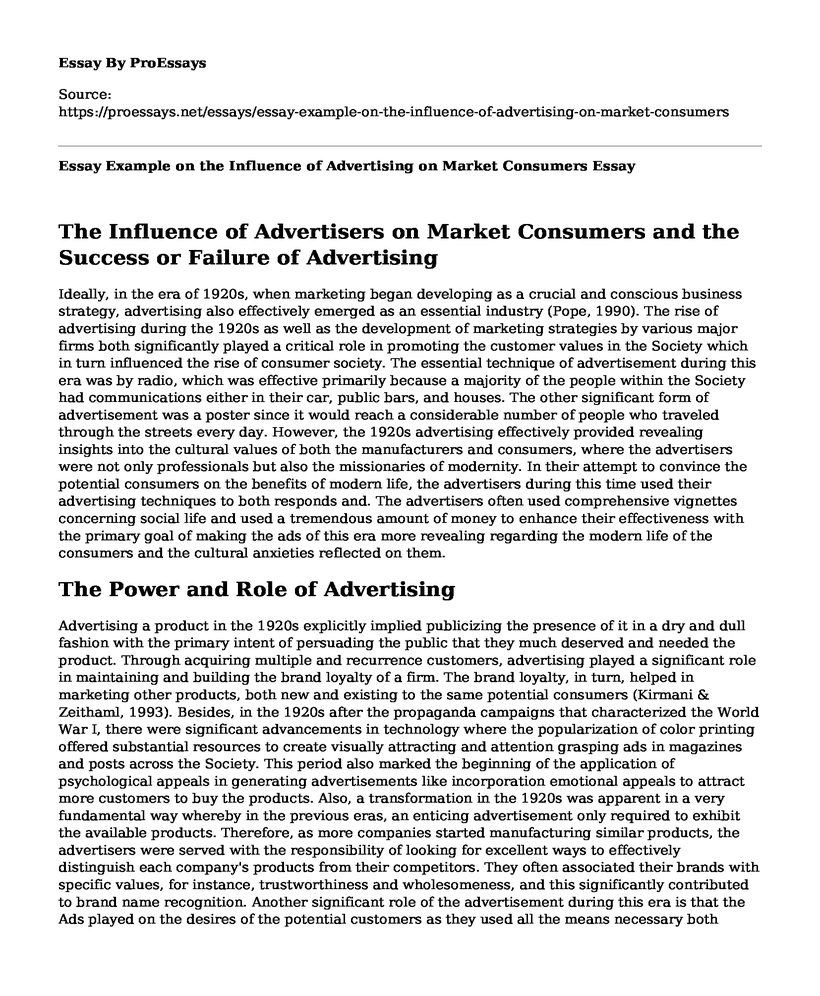The Influence of Advertisers on Market Consumers and the Success or Failure of Advertising
Ideally, in the era of 1920s, when marketing began developing as a crucial and conscious business strategy, advertising also effectively emerged as an essential industry (Pope, 1990). The rise of advertising during the 1920s as well as the development of marketing strategies by various major firms both significantly played a critical role in promoting the customer values in the Society which in turn influenced the rise of consumer society. The essential technique of advertisement during this era was by radio, which was effective primarily because a majority of the people within the Society had communications either in their car, public bars, and houses. The other significant form of advertisement was a poster since it would reach a considerable number of people who traveled through the streets every day. However, the 1920s advertising effectively provided revealing insights into the cultural values of both the manufacturers and consumers, where the advertisers were not only professionals but also the missionaries of modernity. In their attempt to convince the potential consumers on the benefits of modern life, the advertisers during this time used their advertising techniques to both responds and. The advertisers often used comprehensive vignettes concerning social life and used a tremendous amount of money to enhance their effectiveness with the primary goal of making the ads of this era more revealing regarding the modern life of the consumers and the cultural anxieties reflected on them.
The Power and Role of Advertising
Advertising a product in the 1920s explicitly implied publicizing the presence of it in a dry and dull fashion with the primary intent of persuading the public that they much deserved and needed the product. Through acquiring multiple and recurrence customers, advertising played a significant role in maintaining and building the brand loyalty of a firm. The brand loyalty, in turn, helped in marketing other products, both new and existing to the same potential consumers (Kirmani & Zeithaml, 1993). Besides, in the 1920s after the propaganda campaigns that characterized the World War I, there were significant advancements in technology where the popularization of color printing offered substantial resources to create visually attracting and attention grasping ads in magazines and posts across the Society. This period also marked the beginning of the application of psychological appeals in generating advertisements like incorporation emotional appeals to attract more customers to buy the products. Also, a transformation in the 1920s was apparent in a very fundamental way whereby in the previous eras, an enticing advertisement only required to exhibit the available products. Therefore, as more companies started manufacturing similar products, the advertisers were served with the responsibility of looking for excellent ways to effectively distinguish each company's products from their competitors. They often associated their brands with specific values, for instance, trustworthiness and wholesomeness, and this significantly contributed to brand name recognition. Another significant role of the advertisement during this era is that the Ads played on the desires of the potential customers as they used all the means necessary both ethical and unethical to be center of attention on the various publications in which they were contained (Phillips, 2008). A great example of the most potent advertisements was a Colgate Toothpaste Ad - 1924, which was featured in one of the posts in the New York Daily News Magazine and was able to reach millions of consumers and persuade them to buy the product. Also, the Coca-Cola advertisement in the 1920s as a refreshment or a fun food is an excellent example of how advertising in 1920s convinced people of the modern life as today Coca-Cola is one of the biggest and successful companies in the world.
Consumers' Impressions and Sentiments about Advertising
Advertising in the 1920s had a significant impact on the buying behavior and decisions of the consumers. However, the consumers' sentiment about advertising hugely relied on their liking and disliking of the advertised product. A quality advertisement attracted the consumers to purchase the products whereas a poor quality advertisement harmed the consumer's impressions and thus their buying behavior.
References
Kirmani, A., & Zeithaml, V. (1993). Advertising, perceived quality, and brand image. Brand equity & advertising: Advertising's role in building strong brands, 143-161.
Phillips, M. (2008). Marketing Without Advertising: Easy Ways to Build a Business Your Customers Will Love & Recommend. Nolo.
Pope, D. (1990). " Richard S. Tedlow", New and Improved: The Story of Mass Marketing in America (Book Review). Business History Review, 64(4), 780.
Thorson, E., & Duffy, M. (2011). Advertising age: The principles of advertising and marketing communication at work. Nelson Education.
Cite this page
Essay Example on the Influence of Advertising on Market Consumers . (2023, Feb 06). Retrieved from https://proessays.net/essays/essay-example-on-the-influence-of-advertising-on-market-consumers
If you are the original author of this essay and no longer wish to have it published on the ProEssays website, please click below to request its removal:
- Consumer Problem Recognition Essay
- Essay on Amazing Hospitality Inc: Success Factors of Ad Strategy & Customer Service
- Essay Example on Consumerism Flourishes: Impact on US Economy & Culture
- Dell's Strengths: Brand Reputation, Quality Commodities, Mergers, and Acquisitions - Essay Sample
- Essay Sample on Roles of a CEO: The Highest Rank in an Organization
- Apostle Paul: Leadership & Evangelism in Acts - Essay Sample
- Evaluating Airbnb Success in Property Sales & Development - Essay Sample







